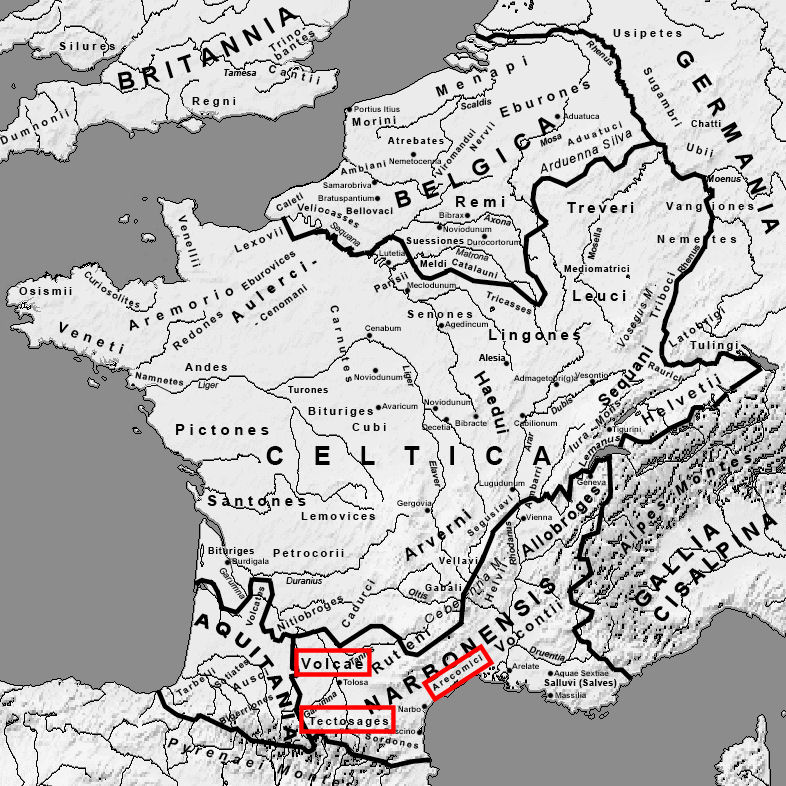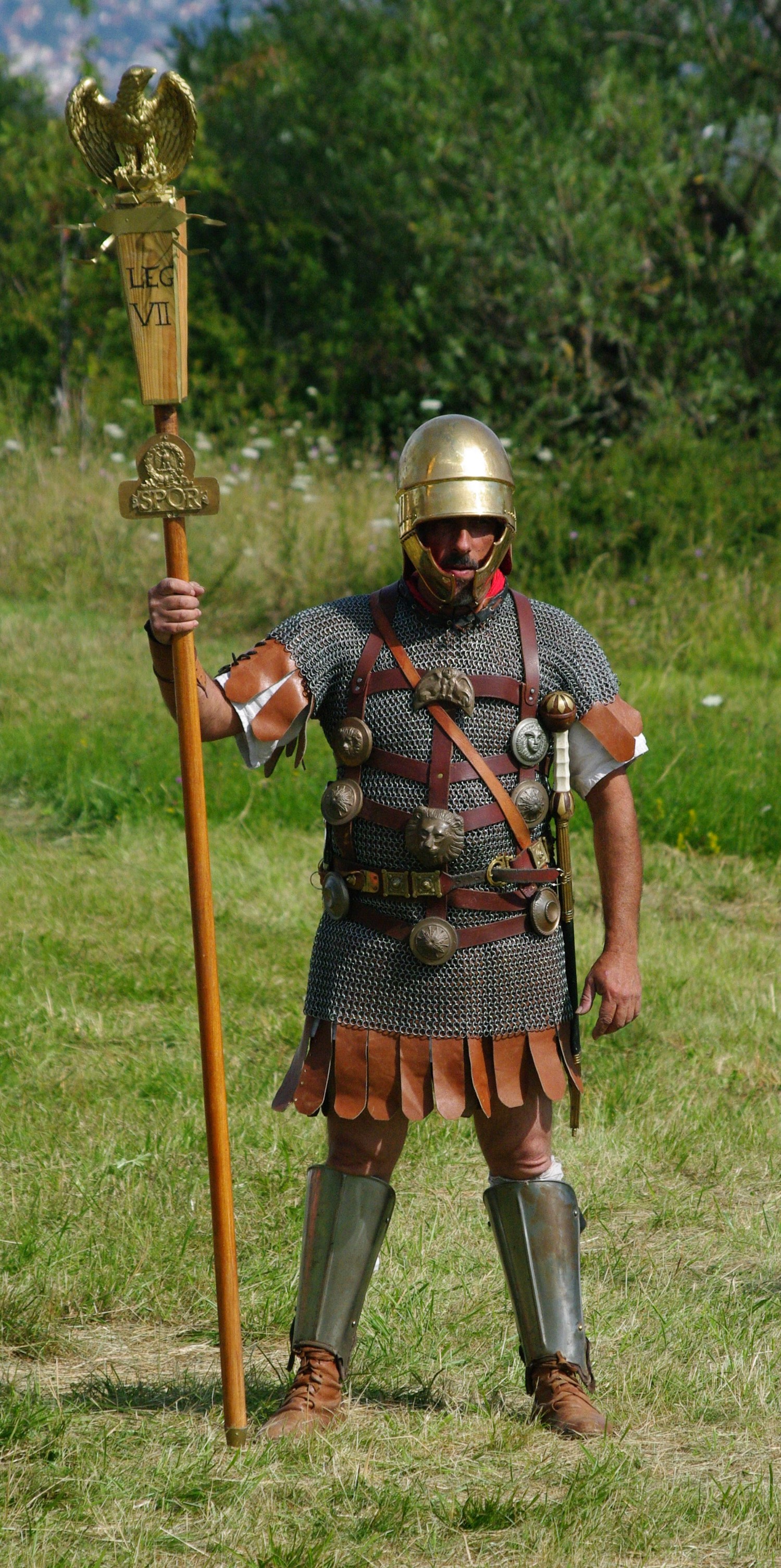|
Ruteni
The Ruteni were a Gallic tribe dwelling in the southern part of the Massif Central, around present-day Rodez, during the Iron Age and the Roman period. Name They are mentioned as ''Rutenos'' by Caesar (mid-1st c. BC), ''R̔outēnoì'' (Ῥουτηνοὶ; var. Ῥουταινοὶ) by Strabo (early 1st c. AD), ''Ruteni'' (var. ''roteni'', ''Rutheni'') by Pliny (1st c. AD), ''Ruteni'' by Lucan, and as ''R̔outanoì'' (Ῥουτανοὶ) by Ptolemy (2nd c. AD)., s.v. ''Ruteni'' and ''Civitas Rutenorum''. The Celticity of the name remains uncertain. It has been tentatively translated as 'the blond ones' by extrapolating from a description of the Roman poet Lucan ("The fair-haired Ruteni were freed from the garrison that long had held them"). The city of Rodez, attested ca. 400 AD as ''civitas Rutenorum'' (' civitas of the Ruteni'; ''in urbe Rutena'' in the 9th c., ''Rodes'' ca. 1183), and the region of Rouergue, attested as ''in pago Rodonico'' in 767 (''Rodengue'', ''Ro ... [...More Info...] [...Related Items...] OR: [Wikipedia] [Google] [Baidu] |
Rodez
Rodez (, , ; , ) is a small city and commune in the South of France, about 150 km northeast of Toulouse. It is the prefecture of the department of Aveyron, region of Occitania (formerly Midi-Pyrénées). Rodez is the seat of the communauté d'agglomération Rodez Agglomération, of the First Constituency of Aveyron as well as of the general Council of Aveyron. Former capital of the Rouergue, the city is seat of the Diocese of Rodez and Vabres. Geography Location Located in the south of France, in the heart of the triangle formed by Toulouse, Clermont-Ferrand and Montpellier, in the western foothills of the Massif Central, the Rodez landscape is situated between the valleys and high plateaus of and the moist hills of Ségala. It extends into , with the communes of Onet-le-Château, Sainte-Radegonde, Le Monastère, Olemps and Luc-la-Primaube, which forms an agglomeration of 83,000 habitants adjoining the city of Rodez. Geology and landforms The territory of ... [...More Info...] [...Related Items...] OR: [Wikipedia] [Google] [Baidu] |
Gabali
The Gabali (Gaulish: *''Gabli'') were a Gauls, Gallic tribe dwelling in the later Gévaudan region during the La Tène culture, Iron Age and the Roman period. Name They are mentioned as ''Gabalos'' or ''Gabalis'' by Julius Caesar, Caesar (mid-1st c. BC), as ''Gabalei͂s'' (Γαβαλεῖς) by Strabo (early 1st c. AD), as ''Gabales'' by Pliny the Elder, Pliny (1st c. AD), and as ''Tábaloi'' (Τάβαλοι) by Ptolemy (2nd c. AD)., s.v. ''Gabali''. The ethnonym ''Gabali'' is a Latinized form of Gaulish *''Gabloi''. It derives from the stem (cf. Old Irish, Olr. ''gabul'', Middle Welsh ''gafl'', Old Breton, OBret. ''gabl''), initially designating the 'forked branch of a tree', then more generally a 'fork'. The name is related to the Gallo-Latin *''gabalottus'' ('spear'), which may have given the word ''javelot'' in French. The city of Javols, attested ca. 400 AD as ''civitas Gabalum'' ('civitas of the Gabali', ''Javols'' in 1109), and the Gévaudan region, attested in the 1st ... [...More Info...] [...Related Items...] OR: [Wikipedia] [Google] [Baidu] |
Gauls
The Gauls (; , ''Galátai'') were a group of Celts, Celtic peoples of mainland Europe in the Iron Age Europe, Iron Age and the Roman Gaul, Roman period (roughly 5th century BC to 5th century AD). Their homeland was known as Gaul (''Gallia''). They spoke Gaulish, a continental Celtic language. The Gauls emerged around the 5th century BC as bearers of La Tène culture north and west of the Alps. By the 4th century BC, they were spread over much of what is now France, Belgium, Switzerland, Southern Germany, Austria, and the Czech Republic, by virtue of controlling the trade routes along the river systems of the Rhône, Seine, Rhine, and Danube. They reached the peak of their power in the 3rd century BC. During the 4th and 3rd centuries BC, the Gauls expanded into Northern Italy (Cisalpine Gaul), leading to the Roman–Gallic wars, and Gallic invasion of the Balkans, into the Balkans, leading to Battle of Thermopylae (279 BC), war with the Greeks. These latter Gauls eventually settle ... [...More Info...] [...Related Items...] OR: [Wikipedia] [Google] [Baidu] |
La Tène Culture
The La Tène culture (; ) was a Iron Age Europe, European Iron Age culture. It developed and flourished during the late Iron Age (from about 450 BC to the Roman Republic, Roman conquest in the 1st century BC), succeeding the early Iron Age Hallstatt culture without any definite cultural break, under considerable Mediterranean influence from the Greeks in pre-Roman Gaul, the Etruscan civilization, Etruscans, and the Culture of Golasecca, Golasecca culture, but whose artistic style nevertheless did not depend on those Mediterranean influences. La Tène culture's territorial extent corresponded to what is now Prehistory of France#The Iron Age, France, History of Belgium#Celtic and Roman periods, Belgium, Early history of Switzerland#Iron Age, Switzerland, History of Austria#Iron Age, Austria, History of England#Later Prehistory, England, History of Germany#Iron Age, Southern Germany, the History of the Czech lands#Iron Age, Czech Republic, Prehistoric Italy#Iron Age, Northern ... [...More Info...] [...Related Items...] OR: [Wikipedia] [Google] [Baidu] |
Arverni
The Arverni (Gaulish: *''Aruernoi'') were a Gallic people dwelling in the modern Auvergne region during the Iron Age and the Roman period. They were one of the most powerful tribes of ancient Gaul, contesting primacy over the region with the neighbouring Aedui. They are mentioned in 207 BC as treating with Carthaginian commandant Hasdrubal Barca. Headed by their chiefs Luernius and Bituitus, the Arverni were at the head of an extensive empire. After Bituitus was defeated by Domitius Ahenobarbus and Fabius Maximus in 121 BC, the Arvernian empire was reduced to suzerainty over some neighbouring tribes. In 52 BC, during the Gallic Wars, the Arvernian chief Vercingetorix led the Gallic revolt against the armies of Caesar. After an initial victory at the Battle of Gergovia, Vercingetorix was defeated by the Romans at the Battle of Alesia, after which the Arverni lost their power of suzerainty. They maintained however a status of '' civitas libera'', and remained a prosperous t ... [...More Info...] [...Related Items...] OR: [Wikipedia] [Google] [Baidu] |
Volcae
The Volcae () were a Gallic tribal confederation constituted before the raid of combined Gauls that invaded Macedonia c. 270 BC and fought the assembled Greeks at the Battle of Thermopylae in 279 BC. Tribes known by the name Volcae were found simultaneously in southern Gaul, Moravia, the Ebro valley of the Iberian Peninsula, and Galatia in Anatolia. The Volcae appear to have been part of the late La Tène material culture, and a Celtic identity has been attributed to the Volcae, based on mentions in Greek and Latin sources as well as onomastic evidence. Driven by highly mobile groups operating outside the tribal system and comprising diverse elements, the Volcae were one of the new ethnic entities formed during the Celtic military expansion at the beginning of the 3rd century BC. Collecting in the famous excursion into the Balkans, ostensibly, from the Greek point of view, to raid Delphi, a branch of the Volcae split from the main group on the way into the Balkans and joined t ... [...More Info...] [...Related Items...] OR: [Wikipedia] [Google] [Baidu] |
Lead
Lead () is a chemical element; it has Chemical symbol, symbol Pb (from Latin ) and atomic number 82. It is a Heavy metal (elements), heavy metal that is density, denser than most common materials. Lead is Mohs scale, soft and Ductility, malleable, and also has a relatively low melting point. When freshly cut, lead is a shiny gray with a hint of blue. It tarnishes to a dull gray color when exposed to air. Lead has the highest atomic number of any stable nuclide, stable element and three of its isotopes are endpoints of major nuclear decay chains of heavier elements. Lead is a relatively unreactive post-transition metal. Its weak metallic character is illustrated by its Amphoterism, amphoteric nature; lead and lead oxides react with acids and base (chemistry), bases, and it tends to form covalent bonds. Lead compounds, Compounds of lead are usually found in the +2 oxidation state rather than the +4 state common with lighter members of the carbon group. Exceptions are mostly limited ... [...More Info...] [...Related Items...] OR: [Wikipedia] [Google] [Baidu] |
Augustus
Gaius Julius Caesar Augustus (born Gaius Octavius; 23 September 63 BC – 19 August AD 14), also known as Octavian (), was the founder of the Roman Empire, who reigned as the first Roman emperor from 27 BC until his death in AD 14. The reign of Augustus initiated an Roman imperial cult, imperial cult and an era of regional hegemony, imperial peace (the or ) in which the Roman world was largely free of armed conflict. The Principate system of government was established during his reign and lasted until the Crisis of the Third Century. Octavian was born into an equites, equestrian branch of the plebeian Octavia gens, Octavia. Following his maternal great-uncle Julius Caesar's assassination of Julius Caesar, assassination in 44 BC, Octavian was named in Caesar's will as his Adoption in ancient Rome, adopted son and heir, and inherited Caesar's name, estate, and the loyalty of his legions. He, Mark Antony, and Marcus Lepidus formed the Second Triumvirat ... [...More Info...] [...Related Items...] OR: [Wikipedia] [Google] [Baidu] |
Gallic Wars
The Gallic Wars were waged between 58 and 50 BC by the Roman general Julius Caesar against the peoples of Gaul (present-day France, Belgium, and Switzerland). Gauls, Gallic, Germanic peoples, Germanic, and Celtic Britons, Brittonic tribes fought to defend their homelands against an aggressive Roman Military campaign, campaign. The Wars culminated in the decisive Battle of Alesia in 52 BC, in which a complete Roman victory resulted in the expansion of the Roman Republic over the whole of Gaul. Though the collective Gallic armies were as strong as the Roman forces, the Gallic tribes' internal divisions eased victory for Caesar. Gallic chieftain Vercingetorix's attempt to unite the Gauls under a single banner came too late. Caesar portrayed the invasion as being a preemptive and defensive action, but historians agree that he fought the wars primarily to boost his political career and to pay off his debts. Still, Gaul was of significant military importance to the Romans. ... [...More Info...] [...Related Items...] OR: [Wikipedia] [Google] [Baidu] |
Battle Of Alesia
The Battle of Alesia or siege of Alesia (September 52 BC) was the climactic military engagement of the Gallic Wars, fought around the Gauls, Gallic ''oppidum'' (fortified settlement) of Alesia (city), Alesia in modern France, a major centre of the Mandubii tribe. It was fought by the Roman army of Julius Caesar against a confederation of List of peoples of Gaul, Gallic tribes united under the leadership of Vercingetorix of the Arverni. It was the last major engagement between Gauls and Romans, and is considered one of Caesar's greatest military achievements and a classic example of siege warfare and Investment (military), investment; the Roman army built dual lines of fortifications—an inner wall to keep the besieged Gauls in, and an outer wall to keep the Gallic relief force out. The Battle of Alesia marked the end of Gallic independence in the modern day territory of France and Belgium. The battle site was probably atop Mont Auxois, above modern Alise-Sainte-Reine in Fran ... [...More Info...] [...Related Items...] OR: [Wikipedia] [Google] [Baidu] |










